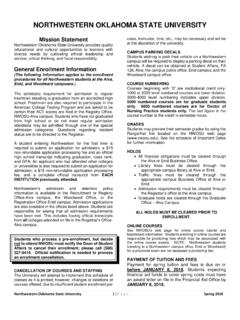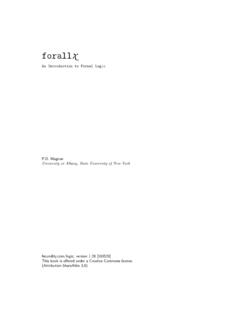Transcription of DSM 5 Substance Use Disorders
1 DSM 5 Substance USE Disorders Ronald W. Kanwischer LCPC, CADC Professor Emeritus Department of Psychiatry SIU School of Medicine I have no financial relationships to disclose with regard to this presentation. This talk is free of commercial bias. What s in a Name? The very naming of something creates new realities, new situations, and often new problems. Thomas D. Watts What s In a Name? An Odious Disease Dr. Benjamin Rush, 1784 The word alcohol didn t come into use until the eighteenth century and was used to designate the intoxicating ingredient in liquor. alcoholism was first used in 1849 by Dr. magnus Huss to describe chronic intoxication with physical and social pathology A century later the word alcoholic was common in the United States Slang and Professional Language used to describe a problem with alcohol and the problem drinker Drunkard Inebriety/Inebriates Tipplers Intemperance Dipsomania (thirst frenzy) Drunkard Barrel fever Alcoholism Jellinek s Disease Problem Drinker Alcoholic Problematic alcohol use Deviant drinker Excessive drinking Addiction (from the Latin, to adore , to surrender oneself)
2 The Evolution of the Concepts of Addiction The history of diagnoses in the DSM reflects the evolving concept of addiction In the DSM the diagnostic decision is binary, they either meet the specific criteria or they do not. In reality, symptoms exist more as if on a continuum. The Evolution of the Concepts of Addiction In the first edition of the DSM in the 1950 s, alcoholism and drug addiction were grouped with sociopathic personality disturbances Signs and symptoms were not described, but instead the idea that addiction came from an underlying brain or personality disorder . The Evolution of the Concepts of Addiction In DSM II (1968) added subtypes of alcoholism.
3 Episodic excessive drinking, habitual excessive drinking, and alcohol addiction. In DSM II, drug dependence was expanded to include subcategories. Specific drug classes and physiological signs of dependence (withdrawal and tolerance) The Evolution of the Concepts of Addiction 1970 s the Feighner criteria are adopted, constructed on research based decision rules This was reflected in DSM III, which also included: The idea of abuse and dependence The term alcoholism was eliminated Substance use Disorders got their own section and were no longer listed under personality Disorders The Evolution of the Concepts of Addiction DSM III, cont. The idea of a public health model was introduced to explain addiction.
4 The dependence category required either tolerance or withdrawal (or both) to be present. Abuse was the presence of drug related problems in the absence of physiological symptoms. The Evolution of the Concepts of Addiction DSM III-R (1987) Reflected a growing concept that addiction really involved a broader behavioral syndrome and was not only defined by physical symptomology. Abuse remained as a category for people who never met the dependence diagnosis. The Evolution of the Concepts of Addiction DSM IV (1994) Over 100 different Substance related Disorders for 12 different classes of drugs. Dependence was now a syndrome involving compulsive use, tolerance or withdrawal.
5 DSM IV-R (2000) Defined Substance abuse as meeting any of the four criteria revolving around recurrent problems related to the Substance The Evolution of the Concepts of Addiction DSM IV-R cont. Dependence has to meet three or more of seven physiological or behavioral criteria. (this left some diagnostic orphans, none of the criteria for abuse and only one or two in the dependence category) DSM V Factor analyses found that the abuse and dependence criteria actually loaded on a single factor and are interrelated with each other. The term addiction is not applied as a diagnostic term, the more neutral term, Substance use disorder is used to describe the wide range of the disorder.
6 American Society of Addiction Medicine, April 2011 Addiction is a primary, chronic disease of brain reward, motivation, memory and related circuitry. Dysfunction in these circuits leads to characteristic biological, psychological, social and spiritual manifestations. This is reflected in an individual pathologically pursuing reward and/or relief by Substance use and other behaviors. Substance Related and Addictive Disorders Changes Gambling disorder is added. No longer separates the diagnoses of abuse and dependence . Criteria are provided for a Substance use disorder with severity judged on the number of criteria met. Also included are criteria for: Intoxication, withdrawal, Substance induced Disorders , and unspecified Substance related Disorders .
7 Substance Related and Addictive Disorders Changes The DSM IV recurrent Substance related legal problems is switched out with craving, or a strong desire or urge to use a Substance . A new criteria threshold is in place to establish a Substance use is now two or more criteria. Past abuse was one or more or three or more for dependence. Substance Related and Addictive Disorders Changes Cannabis withdrawal and caffeine withdrawal are new Disorders . The DSM IV specifier for physiological subtype is eliminated. The DSM IV diagnosis of polysubstance dependence is eliminated. Substance Related and Addictive Disorders Changes Early remission is defined as at least three months but less than twelve months without meeting Substance use disorder criteria (except for craving).
8 Sustained remission is defined as at least twelve months without meeting criteria (except craving). Substance Related and Addictive Disorders Changes Additional Specifiers: in a controlled environment , on maintenance therapy DSM V Criteria for an Substance Use Disorder A problematic pattern of alcohol use leading to clinically significant impairment or distress, as manifested by at least two of the following, occurring within a 12-month period: Impaired Control 1. Alcohol is often taken in larger amounts or over a longer period than was intended. Impaired Control 2. There is a persistent desire or unsuccessful efforts to cut down or control alcohol use.
9 3. A great deal of time is spent in activities necessary to obtain alcohol, use alcohol, or recover from its effects. 4. Craving, or a strong desire or urge to use alcohol. Social Impairment 5. Recurrent alcohol use resulting in a failure to fulfill major role obligations at work, school, or home. 6. Continued alcohol use despite having persistent or recurrent social or interpersonal problems caused or exacerbated by the effects of alcohol. 7. Important social, occupational, or recreational activities are given up or reduced because of alcohol use. Risky Use of the Substance 8. Recurrent alcohol use in situations in which it is physically hazardous.
10 9. Alcohol use is continued despite knowledge of having a persistent or recurrent physical or psychological problem that is likely to have been caused or exacerbated by alcohol. Pharmacological Criteria 10. Tolerance, as defined by either of the following: a. A need for markedly increased amounts of alcohol to achieve intoxication or desired effect. b. A markedly diminished effect with continued use of the same amount of alcohol. 11. Withdrawal, as manifested by either of the following: a. The characteristic withdrawal syndrome for alcohol b. Alcohol (or a closely related Substance , such as a benzodiazepine) is taken to relieve or avoid withdrawal symptoms.








